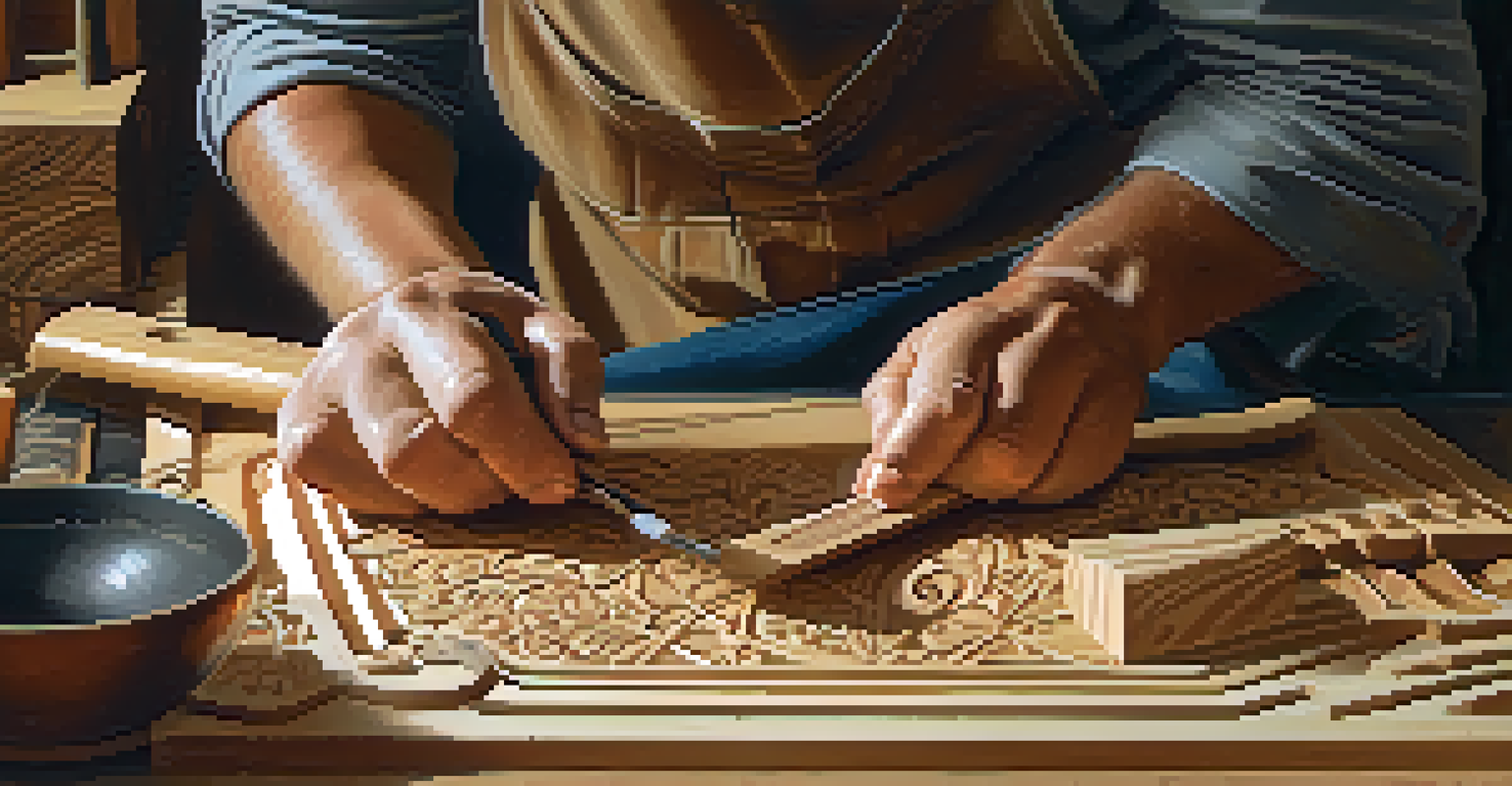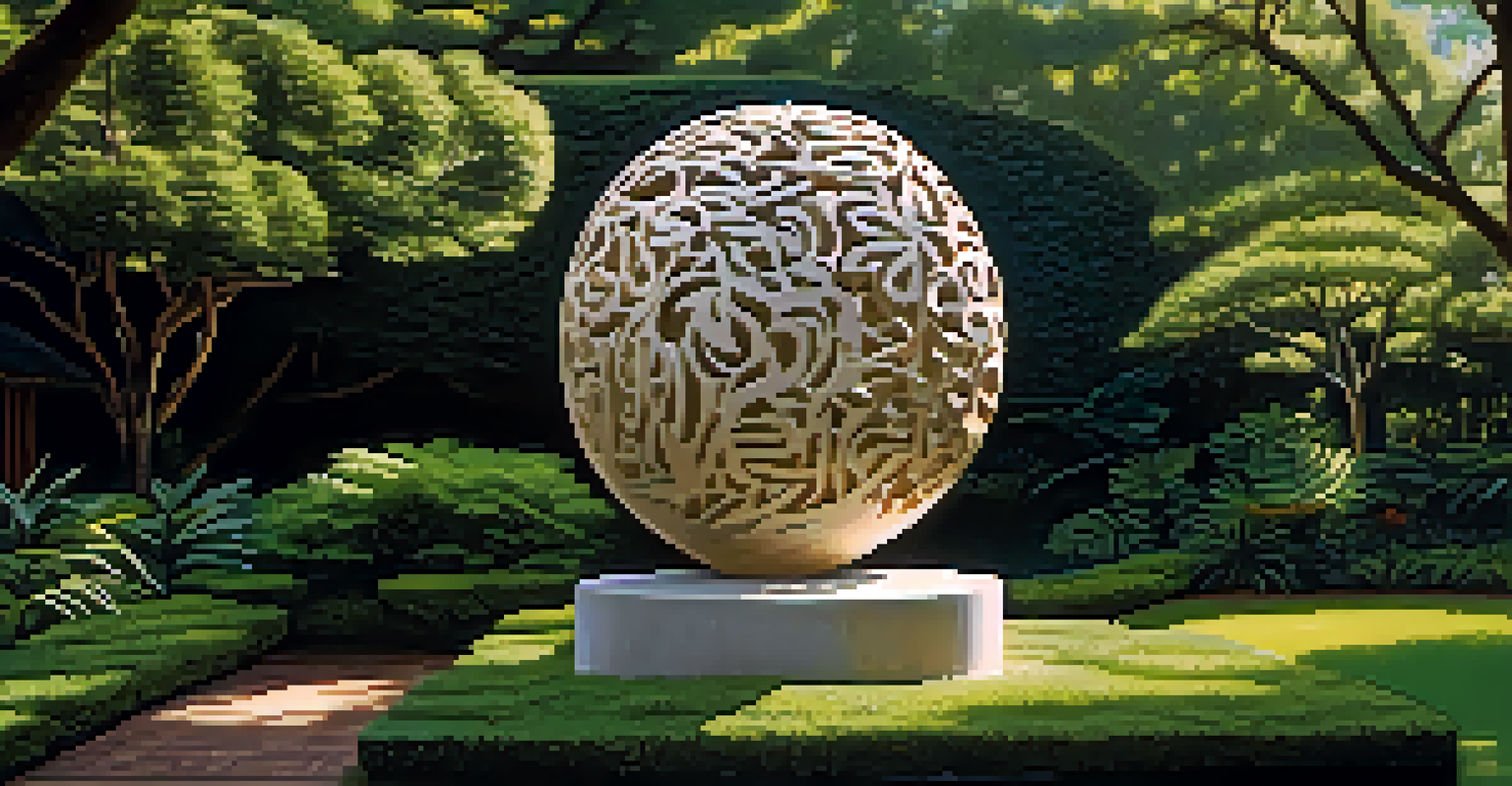The Impact of Globalization on Carving Styles

Understanding Globalization in the Context of Art
Globalization refers to the interconnectedness of the world, where ideas, cultures, and economies exchange freely. In the realm of art, this means that artistic styles and techniques can travel across borders, impacting local practices. This phenomenon has allowed carvers from different regions to share their unique methods and aesthetics, influencing one another in ways that were previously unimaginable.
Art is a way of expressing and connecting cultures, and globalization allows that connection to flourish.
For instance, a traditional woodcarver in Indonesia may discover intricate designs from African artisans through online platforms. This exchange fosters creativity but also raises questions about cultural appropriation and the authenticity of traditional practices. As artists adopt and adapt these influences, they create new styles that may blend multiple cultural elements.
Ultimately, globalization has turned local carving styles into a global dialogue, where each artist contributes to a rich tapestry of artistic expression. This blending creates a dynamic environment for innovation while also challenging the preservation of traditional techniques.
The Evolution of Traditional Carving Techniques
Traditionally, carving styles were closely tied to the cultural and historical contexts of specific regions. Each community had its own motifs, tools, and materials that defined its artistry. However, with globalization, many of these traditional techniques are evolving as artists experiment with new influences and ideas from around the world.

Take the example of Native American carving styles, which have been influenced by contemporary art movements and technologies. Artists are now incorporating modern themes while still honoring their heritage. This evolution allows for a richer narrative within the artwork, making it relevant to both local and global audiences.
Globalization Influences Artistic Styles
The interconnectedness of the world allows artists to share techniques and aesthetics, resulting in innovative new styles.
While this can be seen as a positive development, it also raises concerns about the dilution of cultural identity. As traditional techniques evolve, there's a delicate balance between innovation and preservation that artists must navigate.
Cross-Cultural Collaborations in Carving
Globalization has enabled artists to collaborate across cultures, leading to unique hybrid styles in carving. These collaborations often result in pieces that blend techniques and materials from different traditions, creating something entirely new. By working together, artists can learn from each other, expanding their skills and perspectives.
The beauty of art lies in its ability to transcend boundaries and bring people together, celebrating the diversity of human experience.
For instance, a carver from Japan might team up with a sculptor from Brazil, combining Japanese precision with Brazilian vibrancy. This partnership not only enriches their individual practices but also offers audiences a fresh take on carving art. The cross-pollination of ideas fosters a sense of community among artists, transcending geographical boundaries.
However, these collaborations also require sensitivity to each culture's significance and meaning. It's essential for artists to approach such partnerships with respect and awareness to honor the roots of the techniques they are blending.
The Role of Technology in Modern Carving
Technology plays a pivotal role in the globalization of carving styles, allowing artisans to access resources and techniques that were once out of reach. From digital design software to advanced carving tools, technology has transformed the way artists create. This shift has made it easier for carvers to experiment with new forms and materials, breaking away from traditional methods.
Moreover, online platforms enable artists to showcase their work to a global audience. Social media and e-commerce sites allow carvers to sell their pieces internationally, gaining recognition and support from art enthusiasts worldwide. This exposure can lead to greater demand for unique styles that incorporate diverse influences.
Cultural Sensitivity in Art Practices
As artists borrow from various cultures, it is crucial to navigate cultural appropriation with respect and awareness.
However, as technology continues to evolve, it raises questions about the authenticity of handmade craftsmanship. While tools can enhance creativity, they may also lead to a loss of the personal touch that defines traditional carving.
Cultural Appropriation and Ethical Considerations
With the blending of carving styles comes the important issue of cultural appropriation. As artists borrow elements from different cultures, it's crucial to navigate this territory with care and respect. Cultural appropriation occurs when elements of a culture are used without permission or understanding, often leading to misrepresentation.
For example, when traditional symbols from Indigenous cultures are used in commercial artwork without acknowledgment, it can undermine the significance of those symbols. Artists must strive to honor the cultures they draw from, ensuring that they do not exploit or trivialize them in their work. This ethical consideration is vital in maintaining the integrity of both the art and the cultures involved.
Ultimately, fostering a dialogue about cultural sensitivity in art can lead to more meaningful connections between artists and communities. By acknowledging the origins and meanings behind various techniques, carvers can create work that resonates with authenticity and respect.
The Future of Carving Styles in a Globalized World
As globalization continues to shape the world of art, carving styles will likely evolve further, creating new opportunities for expression and innovation. The blending of influences from various cultures could lead to a renaissance in carving, where artists push boundaries and explore uncharted territories. This future holds exciting possibilities for creativity and collaboration.
However, it's also important for artists to remain grounded in their cultural identities. While embracing global influences, they should seek to preserve the essence of their traditions. Balancing modern techniques with traditional practices can lead to a richer artistic experience that honors the past while looking toward the future.
Diversity Enriches Carving Arts
Celebrating diverse voices in carving fosters appreciation for different cultural narratives and enhances the global artistic landscape.
In this way, the future of carving styles can be seen as a dynamic interplay between tradition and innovation. Artists can create a vibrant landscape of carving that reflects a shared human experience, celebrating both diversity and unity in their craft.
Celebrating Diversity Through Carving Arts
Globalization has opened doors for diverse voices in the carving arts, allowing artists from various backgrounds to share their stories and perspectives. This celebration of diversity enriches the artistic landscape, showcasing a multitude of styles and techniques that reflect the complexities of our global society. Through carving, artists can convey cultural narratives that resonate with both local and international audiences.
Art exhibitions and festivals dedicated to carving have become platforms for showcasing this diversity, bringing together artists from different cultures. These events not only highlight unique carving styles but also promote dialogue about the significance of cultural heritage in contemporary art. They create spaces where artists can connect, collaborate, and inspire one another.

By celebrating the diversity of carving arts, we can foster a greater appreciation for the rich tapestry of human creativity. This recognition encourages inclusivity and understanding, allowing carving to serve as a bridge between cultures, ultimately enriching our shared artistic journey.